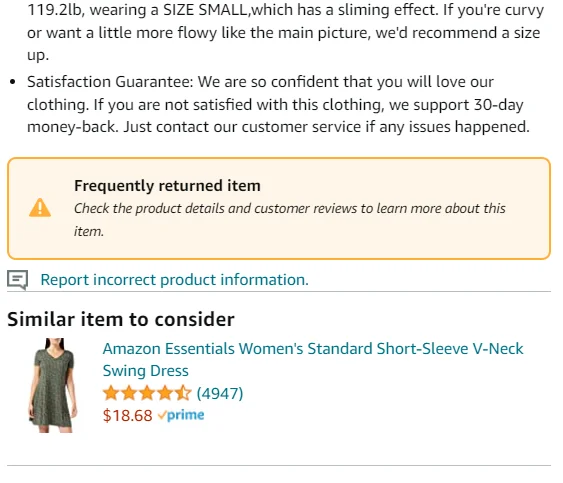Selling on Amazon is a lucrative and fun business until you start receiving return and refund requests. No seller relishes the idea of refunding or replacing sold items. The process is often cumbersome, not to mention the significant loss in profits.
However, returns are an unavoidable and major part of running an eCommerce business, especially if you’re committed to keeping customers happy. Processing returns and refunds are a better alternative than dealing with negative reviews, which can impact your future sales.
The National Retail Federation reports that the average eCommerce return rate jumped from 10.6% in 2020 to 16.6% in 2021. And while returns can be troublesome, 92% of customers will purchase again if the returns process is easy.
One of the many perks of selling through Amazon FBA is that Amazon will handle customer returns for you. With Amazon’s commitment to customer satisfaction, they have a generous returns policy that keeps customers happy and loyal.
In this article, we’ll discuss the key aspects of the Amazon FBA Return Policy and the recent updates for 2023. Let’s dig in!
Key Aspects of the Amazon FBA Return Policy

When a customer wants to return an item they purchased from an FBA seller, they initiate the return process through Amazon’s website or customer service. Here are some key aspects of the Amazon FBA return policy:
Return Window
Amazon typically provides customers with a 30-day return window from the date of delivery to initiate a return for most products. However, certain categories or products may have different return windows, such as electronics or perishable goods.
A buyer also has 15 days from the time their return request was approved to ship the item back to the Amazon warehouse.
When a customer initiates a return, Amazon will send you an email. Amazon recommends responding to the request within 24 hours. To approve a return request, go to Manage Returns and review requests. You can authorize or decline depending on the reasons provided.
Return Reasons
Amazon allows customers to initiate returns for various reasons, including receiving a damaged or defective item, receiving the wrong item, or simply changing their minds about the purchase. The specific return reasons can vary depending on the product category.
Amazon is aware that some customers will abuse their Returns Policy by returning items for no legitimate reason. When they detect this behavior, they will ban the shopper from the site.
Return Shipping
Amazon generally offers customers free return shipping for most products. Customers can print a return label and ship the item back to Amazon using a provided shipping method or drop it off at an authorized location.
However, if Amazon detects that the product value is lower than the cost of return shipping, they will simply refund the customer without requiring a return. This is called a Returnless Refund. Typically, you can set a maximum threshold for how often Amazon can use this option. However, Amazon will sometimes refund the item without the seller’s manual approval.
Refunds and Replacements
Depending on the customer’s preference and the availability of stock, Amazon offers options for either a refund or a replacement for the returned item. If the item is no longer in stock, the customer will usually receive a refund.
You can also compensate a buyer in addition to the refund or you can elect to only refund the item price but not the shipping cost.
If you’re processing a return for a gift item, the gift recipient is only eligible for a gift voucher equivalent to the gift amount.
Condition of Returned Items
Amazon expects returned items to be in the same condition as when they were shipped to the customer. If the item is not in its original condition, the customer may receive a partial refund or be charged a restocking fee.
If you decide to only issue a partial refund, explain the situation to the buyer in advance. This will avoid any misunderstanding and prevent your customer from complaining.
Seller Reimbursements
In cases where a customer returns an item that was damaged or not in its original condition, Amazon may reimburse the seller for the value of the item through the FBA Reimbursement Policy. This policy ensures that sellers are not penalized if Amazon caused damage to the product.
You can also get reimbursed if the customer was refunded but failed to return the item within 45 days of receiving it. Amazon will recharge the customer and reimburse the payment to you. If the reimbursement isn’t automatically processed, you can open a ticket.
You must be aware of and understand the Amazon FBA return policy to effectively manage returns, provide good customer service, and comply with Amazon’s guidelines. You should regularly review the policy for any updates or changes that may impact your operations.
What’s New in 2023?
While returns are inevitable, Amazon knows that it’s best to avoid them at all costs. It’s better for both you and Amazon if you have zero returns. As such, Amazon released a feature called “Return Insights” to give you deeper insights into your returns.
The tool is under the Inventory menu in your Amazon Seller Central dashboard and can be accessed through “Manage FBA returns.” With this feature, you can view return trends and see the top returned items. You can also track your return rate and return reasons.
Here are the metrics you can analyze:
- Returned units
- Product return category
- Return rate percentage
- Return timeframes (30, 60, or 180 days)
- Return reasons
- Returns by ASIN
With this update, you can understand why customers are returning your items and devise ways to address their issues. Is it a concern with your listing or product description? Or maybe it’s because of the product quality?
Whatever the reasons are, with this new tool, you can now reduce your return rates and enjoy higher sales.

This update also coincides with Amazon’s launch of a “Frequently Returned Item” publicly viewable label on items with unusually poor return rates. The label appears as a box at the top of the product details page. This label will help customers identify fraudulent products that aren’t true to their listing despite having lots of five-star reviews.
How the Amazon FBA Return Process Works
To better understand Amazon’s Return Policy, it’s helpful to know what happens behind the scenes. The Amazon FBA return process involves several steps to facilitate the return of products by customers. Here’s an overview of how the process works:
- When a customer wants to return a product purchased from an FBA seller, they initiate the return process through their Amazon account. This can be done by accessing the “Your Orders” section and selecting the specific item they wish to return.
- During the return initiation, the customer provides a reason for the return, such as receiving a damaged item. The reason for the return will help you and Amazon understand the nature of the issue and how to handle the return.
- After the return request is submitted, Amazon generates a return label that the customer can use to ship the item back. The return label includes the customer’s address, the seller’s address, and a unique tracking number.
- The customer is responsible for packaging the item securely for the return shipment. They may use the original packaging if it’s still available, or they can use suitable packaging to ensure the item is protected during transit.
- The customer attaches the provided return label to the package and ships it back to Amazon using the designated shipping method. In most cases, Amazon offers free return shipping for FBA products, making it convenient for customers to return items.
- Once the returned item reaches Amazon’s fulfillment center, it undergoes inspection to verify its condition. If the item is in its original condition, you can re-list it for sale. If the item is damaged or not in its original condition, you may be eligible for reimbursement through Amazon’s FBA Reimbursement Policy.
- Depending on the customer’s preference and item availability, Amazon offers either a refund or a replacement. If the customer requested a refund, the amount will be credited back to their original payment method. If a replacement is requested and available, Amazon ships the new item to the customer.
Throughout the return process, Amazon manages the logistics and customer service aspects, ensuring a smooth and hassle-free experience for both customers and FBA sellers. You can monitor returns through your Amazon Seller Central account and address any customer inquiries or issues related to returns promptly.
It’s important to regularly check your seller account for return requests, communicate with customers, and provide excellent customer service to maintain customer satisfaction and minimize return-related complications.
Options for Returned Items
When it comes to handling returned items as an FBA seller on Amazon, there are several options available for managing these products. Amazon has created these programs to help sellers recoup the loss for returned, damaged, and used items.
- FBA Grade and Resell
The FBA Grade and Resell option allow returned items that are still in sellable condition to be inspected, graded, and listed for resale. Amazon determines the condition of the returned items, assigns a grading category (such as “Used – Like New,” “Used – Very Good,” etc.), and relists them as used items on the Amazon marketplace.
Sellers have the opportunity to continue selling these items at a reduced price, tapping into the market for customers looking for discounted or second-hand goods. This is a great way to recover the cost (or even earn a small profit margin) for products that are still in almost mint condition.
- FBA Liquidations
FBA Liquidations is a program that allows you to recover some value from returned items that can’t be resold as new. Through this program, you can choose to liquidate returned inventory by selling it in bulk to third-party buyers.
Amazon handles the logistics of the liquidation process, including packaging and shipping the items to the buyers. Bulk buyers will pay 5–10% of your product’s average selling price, and Amazon will give you the payment within 60 days.
While liquidation prices are significantly lower than the original selling price, this option enables you to recoup some of your investment rather than discard the items.
To take advantage of this option, visit your Amazon Seller Central and submit a liquidation request when you create a removal order from any inventory.
- FBA Donations
FBA Donations is a program that allows sellers to donate returned items to charitable organizations instead of disposing of them. By participating in this program, you can support worthy causes and contribute to reducing waste.
You can select this option for items that are not suitable for liquidation or resale, ensuring that they serve a purpose and benefit others in need.
Amazon works with Good360, a non-profit organization that helps businesses distribute excess goods to the people who need them the most. This earth-friendly alternative ensures your unused inventory doesn’t end up in landfills and destroy the environment.
It’s important to note that the availability of these options may vary depending on the condition and category of the returned items. Additionally, each option has its own associated fees, processes, and eligibility criteria that sellers need to consider when deciding the best course of action for their returned inventory.
When choosing among these options, you should consider factors such as the potential recovery value, logistics involved, impact on brand reputation, and the overall cost-effectiveness of each approach.
Amazon FBM Return Policy
For sellers who fulfill their own orders, the return process is slightly different. Amazon expects that FBM sellers will match or exceed Amazon’s return policy. If you’re an FBM seller, you must also accept returns within 30 days and refund the customer within 2 days of receiving the returned item.
When customers request a return within the return period, Amazon will send them a prepaid shipping label on your behalf. This will facilitate the speedy return of the unwanted item directly to you. However, this also means you won’t be able to communicate with the seller beforehand to resolve the matter and avoid any automatic refunds. You can, of course, set some rules and parameters so that Amazon will still require your authorization on certain return requests.
Tips to Avoid Customer Returns
While returns are free for customers, it has a steep cost for FBA sellers. First, not all costs are reimbursed, and second, Amazon charges a restocking fee and returns processing fee depending on the condition of the returned item.
To preserve your profit, you should do your best to minimize customer returns. Here are some tips you can follow.
- Provide clear and detailed product descriptions
Include specifications, features, and any limitations. Accurate and comprehensive information helps set appropriate customer expectations and reduces the likelihood of returns due to misunderstandings.
- Use high-resolution images that accurately represent your products
Include multiple angles, close-ups, and any relevant details. Clear and attractive visuals give customers a better understanding of the product, reducing the chances of disappointment upon receipt.
- Use reliable packaging

Ensure your products are packaged securely and appropriately to withstand shipping and handling. Use sturdy materials and padding when necessary to prevent damage during transit. Proper packaging helps maintain product integrity and reduces the risk of returns due to damaged goods.
- Follow strict quality control measures
Implement robust quality control processes to minimize the likelihood of defective or damaged products reaching customers. Regularly inspect your inventory, conduct product testing if applicable, and address any quality issues promptly. Providing customers with high-quality products increases satisfaction and reduces returns.
- Use accurate sizing and fit information
If you sell apparel, shoes, or other items where sizing is crucial, provide accurate size charts, measurements, and fit information. This helps customers make informed decisions and reduces the chances of returns due to incorrect sizing or fit issues.
- Communicate your return policy to customers
Make sure it’s easily accessible on your product listings, website (if applicable), and any customer communication channels. Transparent and customer-friendly return policies instill confidence in buyers and may discourage unnecessary returns.
- Provide prompt customer service
Respond promptly and courteously to customer inquiries and concerns. Provide helpful information, address issues, and offer solutions whenever possible. Proactive and responsive customer service can prevent potential returns by resolving customer problems before they escalate.
- Use detailed product FAQs
Create a frequently asked questions (FAQ) section on your product listings to address common customer inquiries. Anticipate potential questions about product usage, compatibility, or any other relevant concerns. By providing comprehensive information upfront, customers are less likely to return items due to unanswered queries.
- Consider sending post-purchase messages to customers to check if they’re satisfied with their purchase and offer assistance if needed
This proactive approach shows that you value their satisfaction and provides an opportunity to address any concerns before they lead to returns.
- Regularly assess customer feedback and return reasons to identify recurring issues
Use this feedback to improve your products, address common concerns, and refine your overall customer experience. By continuously striving to enhance product quality and customer satisfaction, you can reduce return rates over time.
Remember, while minimizing returns is important, it’s equally essential to handle returns efficiently and professionally when they do occur. Providing excellent customer service throughout the return process can help retain customer loyalty and positive reviews, which are crucial for long-term success on Amazon.
Build a Thriving Amazon FBA Business with Threecolts
Building a successful Amazon FBA business requires accepting product returns. Even if you create the most accurate product listings and adhere to strict quality guidelines, there will always be unforeseen circumstances when a customer will be unsatisfied with their purchase.
And while you can’t avoid processing product returns, you can minimize their impact with the right tools. Threecolts gives you several solutions to ensure you’re not leaving any potential profits on the table. Unreimbursed returned inventory is a lost profit opportunity, but with SellerBench and RefundSniper, you can identify these opportunities and recover what’s due to your account.
You can confidently process product returns without worrying that Amazon will forget or miss any of your reimbursements. Threecolts keeps your profit intact by recovering every penny you’re owed.
So, the next time you get a return request, don’t despair. With the right tools in place, you can confidently process those returns and deliver stellar customer service that will boost your brand reputation and sales.
Source from Threecolts
The information set forth above is provided by Threecolts independently of Alibaba.com. Alibaba.com makes no representation and warranties as to the quality and reliability of the seller and products.




